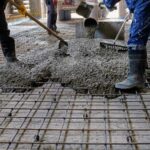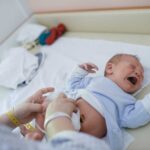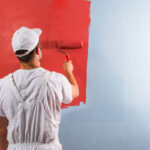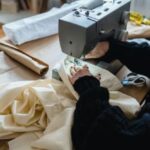No matter what kind of sewing machine you own, there are parts you need to be familiar with. They include things like a thread cutter, a feed dog, and a face plate. They also involve things like a needle bar and a screw fixation.
Needle plate
The best needle plate for your machine is key to making your sewing experience more enjoyable. This part of the machine helps your fabric get pushed up and out of the way so that you can sew with ease.
You may need a different type of plate depending on what kind of sewing you do. There are several different types, but the main attribute of a needle plate is its support for the fabric. Look out for the best embroidery machine for beginners.
The straight stitch plate is great for sewing precise seams on fine fabrics. It provides support for the needle and can prevent puckering. It also reduces the amount of fabric that gets sucked into the needle plate, which can cause skipped stitches.
A straight stitch plate is essential for quilters. It will prevent your fabrics getting sucked into your machine and causing distortions.
The straight stitch plate is also important because it allows you to stitch straight lines. You can also make elegant, smooth stitches with it.
A top-quality needle plate will have a concave table to accommodate the sewing needle hole. It will also have grooves for cloth passing. It may even come with an extra hole for positioning the Spanish Hemstitch Attachment #47.
Needle bar
The needle bar of a sewing machine plays an important part in the formation of the stitch during sewing operations. It can be used in a variety of applications, including sewing cloth and leather. The needle bar must be used correctly. Incorrectly using the needle bar can lead to broken needles or uneven stitches. To avoid vibration, the user must insert the needle correctly into the bar.
There are many other components that can help you sew well. For example, the bobbin screw is another important component. It regulates the tension of the thread. It can also be used to correct an uneven stitch.
The needle plate is another component of the needle bar. This plate is a set o bowl-shaped parts that helps in the movement and operation of the fabric. It is attached to bottom of thread stand. It is also an indicator of the machine’s stitching capabilities.
Attached to the needle bar is a thread take up crank. It has an eccentric undercut recess that reduces vibration. Its effectiveness can be regulated by loosening the clamping screw 233.
Face plate
Several parts make up the face plate of a sewing machine. It is a metal plate which covers the thread-moving bar in a sewing machine. It is secured to the body of the machine by screws or hinges.
A face plate can be made in any shape you like, including an oval, circular, or rectangular. It is typically attached to the left side of a sewing machine. It has a rectangular hole at the top that can hold a bobbin. It also has a groove in the lower portion that is angled toward the front.
A slot may be found on the faceplate of a sewing machine that extends through its rear and side walls. The opening may be large enough to allow all threads to enter or it may be angled so that it is closer to the front.
A sewing needle 32 extends through an orifice in the presser foot 29 and an aperture in the throat plate 22. It is supported by a support bracket and shield 48 that is affixed to the face plate by swaged posts 50. The shield 48 and support bracket 54 extend forward, and the shield 48 is angled inwardly over the canted surface 60 on the faceplate.
Needle clamp
The most important part of a sewing machine is the needle clamp. The clamp is a screw device that holds the needle in place. It is made of a variety of small components, including a cylindrical needle bar, a plastic knob, a g clamp, and a thread guide.
The needle clamp is located at the front of your needle bar. It is usually placed to the right. However, there are machines that have it positioned on the left. This would increase energy consumption and could even cause injury to the operator.
The needle clamp is made from a synthetic resin. It has a knob which is designed to be easily manipulated. The knob has a diameter twice the size of the needle bar. It opens towards the presser bar through a screw-threaded aperture.
A thread guide is attached to the clamp’s bottom. The thread guide helps keep the needle in place. It can be adjusted, depending on your preferences and needs. It is small enough to fit in the needle clamp.
Needle fixation screw
Generally, the needle fixation screw of a sewing machine is a screw threaded aperture in the clamp body that intersects the needle accommodating seat. It is designed to be easy to manipulate. It has an enlarged diameter to fit the needle bar. It can be adjusted by hand or with a screwdriver. Overtightening the clamp screw can break the clamp tip or the body.
The clamp knob is made of synthetic plastic resin. It is twice the diameter of the needle bar. It is placed between the needle and presser bars. It is also integrated molded with the clamp screw.
The suture needle can be removed from the groove of the suture needle installation component. It has a horizontal and a vertical portion. It is placed in an L-shaped installation passage. The horizontal part can be placed in a plane while the vertical part may be at a 90-170 degree angle. The vertical part can be held more securely than the horizontal.
The attachment for circular sewing of a sewing machine is provided with structure of claim 1. It includes a movable frame, the front left and right sides of the needle position and a scale section at one end of the movable frame. The movable frames can be moved to either the right or left. The scale section is positioned at the end of the movable frame and overlaps to support the section.
Feed dogs
Often overlooked, sewing machine feed dogs are actually an important part of your sewing machine. They are metal teeth-like ridges that help you produce a smooth and precise stitch.
There is usually a lever on your sewing machine to raise or lower the feed dogs. To set the feed dogs, align the valleys of your teeth with the plate at its highest point of travel.
The proper feed dogs will keep your fabric even and tension across its width. If you are having timing problems with your sewing machine, you may want to check the feed gears and bobbin. You can also try different settings to find the best one.
Some sewing machines have a special plate to cover the feed dogs, while others don’t. If your machine doesn’t have one, you can cover the feed dog holes with a piece of playing cards or plastic.
You might consider lowering the feed dogs if they aren’t working properly. This will let you freehand sew with less tension. You may need to increase the length of your stitch depending on your sewing machine.
Thread cutter
Several sewing machines come with a thread cutter on the underside of the needle plate. The thread cutter cuts the needle threads and bobbin without the need to use scissors. This is a handy device to have on your sewing machine.
A thread cutter for a sewing machine comprises a first thread seizing assembly, a second thread seizing assembly, and a drive mechanism. The drive mechanism includes a steppingmotor, a drive motor, a swing lever, and a cam. The drive pin is driven by the stepping motor to turn the swing drive lever. The drive lever then rotates in a direction to seize the first thread.
The first thread seizing assembly is located at the left side of the thread cutter. Elongated grooves 31 and 30 support the first thread seizing assembly. The auxiliary shaft 64 is located parallel with the lengthwise direction for the first thread-seizing assembly. To the right of the auxiliary shaft is the swing shaft 63. The horizontal spool pin holds the spool of thread.
The second thread seizing assembly separates the bobbin from the needle threads. The distal end the second thread sewing assembly has been forked into the second thread seizing portions 38a and 38b.





